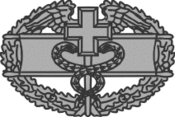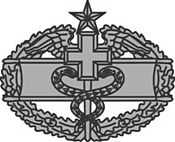Combat Medical Badge
| Combat Medical Badge | |
|---|---|
 | |
| Awarded by United States Army | |
| Type | Badge |
| Eligibility | An army medic supporting a ground combat arms unit brigade or lower. Restricted to ranks of colonel and below at time of award. |
| Awarded for | Performing medical duties while being actively engaged by the enemy. |
| Status | Currently awarded |
| Statistics | |
| Last awarded | Ongoing |
| Precedence | |
| Next (higher) | Combat Infantryman Badge |
| Next (lower) | Combat Action Badge[1] |
The Combat Medical Badge is an award of the United States Army which was first created in January 1945. Any member of the Army Medical Department, at the rank of Colonel or below, who is assigned or attached to a medical unit (company or smaller size) which provides medical support to a ground combat arms unit during any period in which the unit was engaged in active ground combat is eligible for the CMB. According to the award criterion, the individual must be performing medical duties while simultaneously being actively engaged by the enemy; strict adherence to this requirement and its intrepretation (e.g., distant mortar rounds vs. direct small arms fire) will vary by unit. As of June 3, 2005, Special Forces medics are no longer eligible for award, but may now receive the Combat Infantryman Badge.[2] A revision has allowed aviation medics to be eligible for the CMB.[3] The non-combat proficiency equivalent is the Expert Field Medical Badge.
The Combat Medical Badge is retroactive to December 6, 1941. The original decoration was considered a one-time decoration, however this directive was rescinded in 1951 allowing for multiple awards of the Combat Medical Badge denoted by stars encircling the decoration.[4] According to the US Army Medical Department Regiment, to date there have been two Soldiers that have earned the Combat Medical Badge with two stars Henry Jenkins and Wayne Slagel. { http://ameddregiment.amedd.army.mil/heraldic/triple.html } The directive was again altered in 1969 to specify that only one award of the Combat Medical Badge is authorized for service in Vietnam, Laos, the Dominican Republic, South Korea (subsequent to 4 January 1969), El Salvador, Grenada, Panama, Southwest Asia, Somalia, Iraq and Afghanistan regardless of whether an individual has served in one or more of these areas.
In 1947, a policy was implemented that authorized the retroactive award of the Bronze Star to soldiers who had received the Combat Medical badge during the Second World War. The basis for doing this was that the Combat Medical Badge was awarded only to soldiers who had borne combat duties befitting the Bronze Star Medal and also that both awards required a recommendation by the commander and a citation in orders.


The CMB is authorized for award for the following qualifying periods:[5][6]
- World War II (7 December 1941 to 3 September 1945).
- The Korean War (27 June 1950 to 27 July 1953).
- Republic of Vietnam Conflict (2 March 1961 to 28 March 1973), combined with qualifying service in Laos (19 April 1961 to 6 October 1962).
- Dominican Republic (28 April 1965 to 1 September 1966).
- Korea on the DMZ (4 January 1969 to 31 March 1994).
- El Salvador (1 January 1981 to 1 February 1992).
- Grenada (23 October to 21 November 1983).
- Joint Security Area, Panmunjom, Korea (23 November 1984).
- Panama (20 December 1989 to 31 January 1990).
- Southwest Asia Conflict (17 January to 11 April 1991).
- Somalia (5 June 1992 to 31 March 1994).
- Afghanistan (Operation Enduring Freedom, 5 December 2001 to a date to be determined).
- Iraq (Operation Iraqi Freedom, 19 March 2003 to 31 December 2011).
With the changes in military structure there has been some questions when it comes to the term direct support in the badge's eligibility. A statement was added to Army Regulation 600-8-22 to address this issue.
Over the years, there has been some confusion concerning the phrase "...in direct support of an infantry unit...". The CMB is intended for, and awarded to, those medical personnel who accompany the infantryman into combat. ... During the World War II era, medical support for infantry units in combat was provided by the medical detachments and companies of battalions and regiments. These medical personnel and units were termed direct support. This concept lasted until Vietnam. Today, medical personnel are assigned as organic personnel to infantry companies and are regarded as participants as opposed to being categorized as those providing direct medical support. For example, medical personnel serving in division-level medical companies, ground ambulance and medical clearing companies, mobile-Army surgical hospital, combat-support hospital, field hospitals, and aero-medical evacuation units are not eligible for the CMB. The sole criteria that qualifies medical personnel for award of the CMB is to be assigned or attached to an infantry unit engaged in active ground combat. Medical personnel other than those medics organic to infantry units may qualify only if they serve as medical personnel accompanying infantrymen....[7]
As of June 2011, the badge and its sew-on equivalent may be worn on the Army Combat Uniform (ACU).[8]
See also
References
- ↑ Army Regulation 600-8-22 Military Awards (24 June 2013). Table 8-1, U.S. Army Badges and Tabs: Orders of precedence. p. 120
- ↑ Sec. 578.69 2008 Combat Infantryman Badge
- ↑ MILPER MESSAGE NUMBER : 08-190
- ↑ multiple awards
- ↑ Sec. 578.70 Combat Medical Badge 2008
- ↑ HRC Combat Medical Badge CMB
- ↑ Army Regulation 600-8-22 Military Awards (24 June 2013). para. 8-7h(4), p. 104
- ↑ Secretary of the Army, Army Directive 2011-11, June 11, 2011
External links
- Wear and Appearance of Army Uniforms and Insignia
- Uniform Poster
- 578.70 Combat Medical Badge
- Army Times: New combat badge rules
| ||||||||||||||||||||||||||